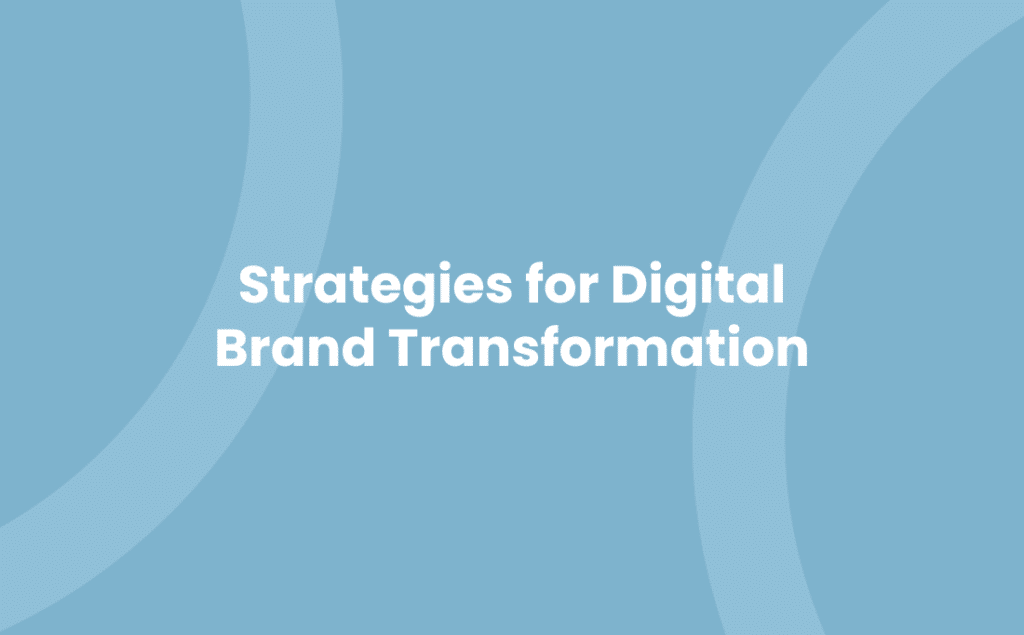It’s crucial to keep up with the current pace of technological change. That’s where digital transformation and brand digitalisation strategies come into play. These are not just buzzwords; they’re game-changers that can catapult your business into the future.
Digital transformation is all about using technology to enhance your business operations, while brand digitalisation focuses on leveraging digital platforms to strengthen your brand presence. But how can you effectively implement these strategies? What are the pitfalls to avoid? Let’s delve into the world of digital transformation and brand digitalisation strategies to unearth the answers.
An exciting journey awaits. So buckle up, and let’s explore the digital landscape together.
Understanding Digital Transformation
Digital transformation represents an essential shift in the business landscape, but it’s more than a mere trend. Exploring its nuances allows for a better comprehension of why it proves crucial in today’s digital age. As a business owner operative within the realms of the United Kingdom’s Small and Medium Enterprises (SMEs) sector, understanding this change brings invaluable benefits.
Digital transformation operates on a remarkable premise, harnessing digital technologies to modify existing, or invent completely anew, business processes and customer experiences. Modifications catalyse improvement in operational procedures and strategic approaches, all within the aim of functioning as a digital-first organisation.
A central part of this transformation includes brand digitalisation, it serves as a strategy to permeate your brand’s presence in the digital sphere. Primarily, it connects your brand to your target audience using digital spaces. Brand digitalisation and digital transformation align to bolster your brand’s visibility while tailoring an enhanced customer experience.
Recall, digital transformation isn’t solely about technology. Surprisingly, it’s more about people and the changes in their behaviour. It’s about how businesses adapt to match customer habits. For example, with the rise of shopping online and the constant need for instant customer service response, businesses must digitally transform to meet, and ideally exceed, these evolving consumer requirements.
In the sea of ever-updating tech, understanding digital transformation equates to staying afloat, and embracing it can transform your business from a simple vessel to a dominant flagship. By knowing how this process works, you’re unlocking the vital tools to future-proof your business, consistently adapting and delivering quality services to your customers in an increasingly digital age.
Strategies for digital transformation, including your brand digitalisation plan, are stepping stones on your journey to digital success. Though the route may appear densely packed with technology jargon, the important focus remains on enhancing your customers’ experience and streamlining your business processes. Lastly, tailored strategies are vital for navigating the intricacies of the digital world, guiding your business towards success in this ever-evolving landscape. It serves as a sturdy anchor, enabling you to sail smoothly even during digital storms.
Exploring Brand Digitalisation Strategies
Unleashing potential, brand digitalisation illuminates the path toward success in today’s digitally driven business landscape. This section delves into potential strategies for effectively digitising your brand.
- Develop a Digital First Mindset: Initiate a ‘digital-first’ perspective across all business operations. Prioritise digital platforms for advertising initiatives, customer interaction, and service delivery. This shift in mindset enables effective utilisation of digital capabilities.
- Utilise Data Analytics: Harnessing the power of data analytics plays a pivotal role in strategic digitalisation. Use data to inform decisions about website design, content creation, and campaign management. Through analytics, identify customers’ browsing habits, preferences, and interactions, directing this knowledge to optimise your digital presence.
- Ensure Mobile Optimisation: In 2021, 56% of website traffic was mobilised worldwide, strongly suggesting a focus on mobile optimisation. Make certain that your website is equally functional, attractive, and user-friendly on mobile devices, granting customers flexibility in device choice when engaging with your brand.
- Engage in SEO Practices: A non-negotiable factor, Search Engine Optimisation (SEO), aids in enhancing your brand’s visibility on search engines. Incorporate relevant keywords, produce high-quality content, and provide a smooth user experience, enriching your site’s ranking and visibility.
- Establish and Maintain Social Media Presence: A strong social media presence forms an essential part of a holistic digitalisation strategy. Keep regular, engaging interactions flowing on social platforms, delivering on-point, high-quality content. Remember that social media is a two-way street; consistency in monitoring, engaging, and responding creates a compelling and approachable brand persona.
- Offer Multichannel Experiences: Consumers make use of various channels such as websites, mobile apps, and social media, to engage with brands. Providing them coherent, consistent experiences across these channels fosters customer satisfaction and loyalty.
- Deploy Customer-Centric Content: Engaging content lures in customers, retains them, and optimises interactions with your brand. Adopt a user-centric approach, generating content that resonates with the interests, needs, and challenges of your target audience.
Brand digitalisation, much like digital transformation branding, requires time and unyielding commitment, yet can propel a brand into meaningful, profitable digital interactions. Navigate this digital realm strategically, leverage these strategies, and steer your brand towards digital excellence.
The Interplay between Digital Transformation and Brand Digitalisation
Diving headfirst into the sea of brand digitalisation and digital transformation is no small decision for your business. So here’s the crux of the matter: these two terms are intriguingly intertwined and unravel different aspects of the same grand tale. Digital transformation forms the underlying base, with brand digitalisation being the icing on the cake, providing that final, polished touch for your SME’s digital representation.
Digital transformation sets the stage. It orchestrates the shift of your business methods, products, and services onto the digital platform. Think along the lines of replacing manual processes with automated ones, transferring data to the cloud and enhancing workflow with tech tools. It forms the roots of your business tree, seeping into the veins of your company’s operation.
Enter brand digitalisation, the process that puts a digital twist on your branding strategy. As the standards of engagement change, your brand’s presence online becomes increasingly important. Be it social media, SEO practices, or mobile optimisation; brand digitalisation involves it all, and, if done right, can give your brand the digital voice it desires.
So where does the magic happen? At the juncture where these two processes overlap. This merger spot forms a key to unlock abundant possibilities for your business in the digital dimension. When intertwined, digital transformation and brand digitalisation pave the way for improved customer satisfaction, enhanced brand visibility, and effortless operation in the market.
Indulge in intelligent data analytics, adapt an agile approach, and above all, prioritise customer-centricity. Digital transformation and brand digitalisation party together, echoing the tune of business efficiency, productivity, and improved customer interactions.
Phew, quite a ride, wasn’t it? But remember, this isn’t a sprint; it’s more of a marathon. So, gear up, because once you embark on this digital journey, the digital realm is your playground, and success is just around the corner.
Steps to Implement Digital Transformation and Brand Digitalisation
Embarking on the journey of digital transformation and brand digitalisation might seem like diving into unchartered waters, but fret not, this guide offers an easy-to-understand roadmap. Follow these steps and your business will emerge stronger and more adaptable in the digital market.
- Establish Clear Objectives: Define the end-goals for your digital transformation and brand digitalisation, such as enhancing customer experience, improving operational efficiency, or expanding your online presence. Consistency in your aims provides a sense of direction during the digital journey.
- Carry Out a Digital Capability Audit: Understand the current digital capabilities of your company by scrutinising the existing technology, employee skills, customer reactions, and other essential factors. This assessment assists in identifying gaps, streamlining operations, and unveiling potential avenues for digitalisation.
- Develop a Digital Transformation Strategy: Fashion a strategic roadmap for digital transformation based on your clear objectives and the capability audit. This roadmap can serve as a guiding path, outlining key milestones, resources required, timelines, potential risks and mitigation strategies.
- Adopt a Customer-centric Approach: Prioritise improving the customer experience, by focusing on aspects like user-friendly design, personalisation, and prompt customer support. A happy customer can boost your brand presence online, leading to increased visibility and reputation.
- Digitalise Your Branding Strategies: Invest in well-crafted digital marketing initiatives, covering SEO, social media, blogs and mobile optimisation. These efforts enhance your online presence, convert leads, and result in quantifiable growth.
- Create a Culture of Change: Foster a positive attitude towards change within your organisation. Encourage staff to embrace new technologies and drive them to be part of the transformation, significantly enhancing the likelihood of a successful digital revolution.
- Monitor and Refine Strategy: Regularly review your progress against the objectives and fine-tune your strategies accordingly. Employ analytics tools to track key performance indicators (KPIs) and quantifiable results, adjusting the strategy to better fit the evolving digital landscape.
Remember that digital transformation and brand digitalisation aren’t one-time events, they’re ongoing processes adapting to technological advancements and consumer behaviour changes. Starting with these steps, you can navigate the digital terrain with more confidence, leading your brand to exciting new horizons. Remember, digitalisation isn’t merely a sprint, but rather a marathon, slow but steady steps will create lasting transformations.
Business Cases of Successful Digital Transformation and Brand Digitalisation Strategies
Jump-start your digital journey, observing these shining exemplars of successful digital transformation and brand digitalisation. These successful case studies exemplify the idea that consistent progress in this digital marathon leads to elevated wins.
- Starbucks: A Seamless Blend of Technology and Taste
Starbucks, a household name for many, illustrates brilliant digital transformation. Integrating the use of a customer-friendly app, they’ve fostered loyalty among customers, offering personalised rewards and easy payment options, illustrating how digital transformation enhances customer experiences. - Nike: Sprinting Ahead with a Click
Much like running a marathon, Nike has adopted an ongoing digital approach. They expanded into a digital marketplace, using innovative technologies, setting a superior example of brand digitalisation. This brand digitalisation strategy contributes to Nike’s global brand recognition, thereby making it a ‘sole’-ful winner. - Dominos: Delivering Pizzas with a Digital Twist
Dominos’ digital transformation journey allows one to order a pizza with just a tweet. This digital-powered convenience, mixed with a wide array of price-friendly options, has garnered them a big slice of popularity, showing a clear interplay between digital transformation and brand digitalisation.
It’s time for your business to join the digital transformation bandwagon using effective brand digitalisation strategies. Tie your laces, set your pace, and embark on this digital marathon. Your brand’s successful digital transformation awaits your first step.
Key Challenges in Digital Transformation and Brand Digitalisation
Given the inherent complexity of a digital transformation, you may encounter a few roadblocks on the path to brand digitalisation. You’re not alone in this journey, and several common difficulties are often faced by businesses, regardless of size or industry:
- Preservation of Corporate Identity: For businesses, embracing change while maintaining your unique corporate identity proves a balancing act. Your brand represents your business ethos, values, and customer promise. Therefore, maintaining this identity while undertaking a digital makeover is one of the prime hurdles.
- Technological Adaptation and Integration: Selecting the right technology isn’t just about picking the most updated, sophisticated model. It involves considering its compatibility with existing systems, ease of deployment, future-proof configurations, and scalability for growth.
- Data Security: Digitisation opens the gateway to cyber threats, dangers, and breaches. Ensuring secure data storage and transactions, safely maintaining customer data, establishing stringent digital security protocols – all these are equally important as embarking on digitalisation.
- Customer Experience Management: Providing personalised customer experience on digital platforms tests your web functionalities, user interface, and overall digital service quality. Regular site audits, updates, and enhancements become prerequisites.
- Resistance to Change: Often, reluctance among employees towards digital reform significantly hampers the process of transformation. Getting your team onboard, training them adequately, and assuring their job security are of utmost importance in a smooth digital transition journey.
- Meeting Legal Regulations: Digitalisation exposes you to a whole new world of legal norms and compliances, particularly in data handling. Complying with data laws and maintaining ethical business practices balances your digitalisation efforts.
Remember that at every hurdle there’s also an opportunity to learn, adapt, and grow. By intelligently navigating these challenges, you’re not just enhancing your digital presence; you’re preparing your business to thrive in the digital reality of the 21st century.
Effective Tips for a Smooth Digital Transformation and Brand Digitalisation Process
Embarking on a digital transformation journey? Incorporating brand digitalisation into your roadmap? Here are a few effective tips to ensure smooth sailing:
- Embrace a Change-first Mentality: Adopt a mindset that welcomes change, and inspire this mentality among your employees. Digital transformation involves revamping traditional processes, which could raise questions, if not resistance. Demonstrating a change-first mentality creates an environment where innovation flourishes.
- Make Data Security Paramount: Digital transition increases the risk of data breaches. Keep proactive about data security; invest in state-of-the-art security systems and organise regular training sessions for your employees about the latest cyber threats and how to counter them.
- Put Your Customers First: Remember, your digital transformation’s ultimate goal is to offer seamless customer experiences. Test all changes from a customer’s perspective and gather their feedback regularly.
- Invest in Skill Development: Digital transformation requires your team to acquire new skills. Develop a comprehensive training program that equips your employees to work efficiently with new technologies.
- Choose the Right Partners: Digitalisation isn’t a job you tack onto an existing employee’s role. Partner with digital transformation firms who have the expertise and resources to guide your journey.
- Plan for Potential Legal Implications: Navigating legal regulations may seem complex, especially in the digital realm. Ensure you have legal advice to understand and meet these regulations.
- Align Your Digital Transformation with Your Branding Strategy: Digital transformation isn’t only about bringing changes at the operational level. It presents an opportunity to weave your brand’s values and vision into every digital touchpoint. Applying your branding strategy to your digital transformation fundamentally improves your brand digitalisation.
Each of these tips not only eases your digital transformation but also aligns it more precisely with your brand digitalisation strategy. Remember, this process requires patience and perseverance, but with the right approach, you can get through this transition smoothly and effectively.
The Future of Digital Transformation and Brand Digitalisation
As we progress into the digital era, technology’s grasp strengthens, with brands navigating the complex realm of digital transformation. For businesses to remain competitive, integrating digital transformation and brand digitalisation is no longer optional; it evolves into a quintessential strategy.
To enhance customer experiences, business owners repurpose their traditional storefronts into interactive, digital platforms, expanding their reach. This strategy paves the way for tailored customer experiences, which not only foster loyalty but also drive business growth.
In this fluid, digital landscape, businesses strategically design their services, ensuring they resonate with the digital age’s customer expectations. In the world of digital transformation, Starbucks innovatively used AI to personalise menu recommendations, vastly improving the customer experience and driving sales.
Data-driven marketing strategies also play a significant role in brand digitalisation. By analysing data patterns and consumer behaviour, businesses can deliver targeted marketing campaigns and realise their utmost potential in the evolving digital age.
Collaborative networks are yet another trending aspect of brand digitalisation. Companies collaborate on digital platforms, which not only expands their customer base but also diversifies their offerings.
Numerous sectors have already embraced digital transformation and brand digitalisation strategies, with SMEs set to follow. This shift won’t only streamline operations, but it will also revolutionise customer experiences.
For the business sector, the future lies in the successful execution of brand digitalisation and digital transformation strategies. Not merely following a trend, but morphing business operations, upskilling employees, and adapting marketing goals to align with the evolving digital trends.
With digital transformation and brand digitalisation on an upward trajectory, the businesses that prioritise these strategies will unlock significant growth opportunities in the future. The secrets to success in the complex world of digital commerce lie in robust strategies, meticulous execution, and leaving no stone unturned.
This promising future of digital transformation and brand digitalisation underpins the importance for SMEs to adapt. After all, this isn’t merely about surviving in an ever-changing digital age. It is about thriving and growing amid the complexities of the realm of digitalisation.
Conclusion
You’ve seen how digital transformation and brand digitalisation strategies are reshaping businesses. Giants like Starbucks, Nike, and Dominos have set the pace, overcoming challenges to reinvent their operations and customer experiences. It’s clear that the future of business lies in repurposing storefronts, using data-driven marketing, and nurturing collaborative networks. SMEs aren’t left out; they’re also unlocking growth opportunities by prioritising digital strategies. So, as you navigate the evolving digital landscape, remember that embracing these strategies isn’t just an option, it’s a necessity to thrive. The digital era is here, and it’s time to step up, adapt, and seize the opportunities it brings.


